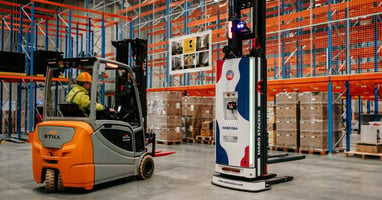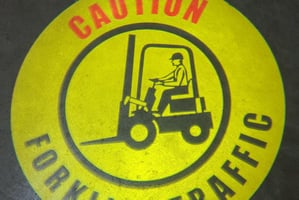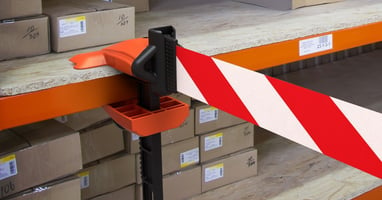Warehouse automation is transforming the logistics and manufacturing industries by increasing...
How To Implement Safety Zones in Your Warehouse

Warehouses are complex environments where efficiency and safety must co-exist. With heavy machinery, frequent human activity, and densely packed inventory, even minor lapses in safety can lead to significant consequences. One effective way to maintain a safer warehouse is by establishing safety zones.
Let’s discuss how to implement safety zones in your warehouse step by step. From assessing your current situation to planning, execution, training, and compliance, this roadmap can help you revolutionize your safety practices and contribute to a more productive work environment.
What Are Safety Zones Used for in a Warehouse?
Safety zones are designated areas within a warehouse created to safeguard employees, streamline operations, and prevent accidents. These zones clearly mark areas for specific tasks or restricted usage to reduce overlap between pedestrians and machinery, such as forklifts or conveyor belts.
Examples of safety zones include:
- Pedestrian walkways
- Forklift or machinery operation areas
- Storage zones for heavy goods
- Shipping and receiving docks
- Safety equipment stations
By visually separating these spaces, you enhance worker clarity, reduce the risk of accidental injuries, and ensure a more efficient workflow.
Assess Your Warehouse Layout First
Before implementing safety zones, evaluate your current warehouse layout. Every warehouse has unique requirements, so it’s crucial to assess yours thoroughly.
Start by asking the following questions:
- How are goods currently flowing through the facility?
- Where does heavy machinery operate regularly?
- Are there areas prone to congestion or accidents?
- Are emergency exits and routes easily accessible?
Your assessment should highlight problem areas. For example, look for spaces where forklifts and human traffic intersect or where poorly marked emergency routes hinder evacuation plans. A clear understanding of your layout will provide the foundation for choosing the optimal locations for safety zones.

Plan Your Safety Zones
Once you’ve assessed your warehouse layout, the next step is planning your safety zones. Think strategically about how you divide your space. Consider the specific tasks being performed in each area and the roles of the workers operating within those spaces.
For example, create separate zones for tasks like packing, unloading, and storage. Ensure that pedestrian walkways don’t overlap with machinery lanes to minimize risks of collisions. Each zone should have clearly defined purposes to minimize confusion and maximize safety.
A successful safety zone plan blends functionality with protection. When planning, consider your operational bottlenecks, traffic flow, and ergonomic requirements. Collaboration with team members during this stage often reveals practical insights you might not have noticed otherwise.
Choose the Right Tools and Materials
Selecting the appropriate tools and materials is essential to implementing effective and durable safety zones in a warehouse. The right choices will ensure clarity, longevity, and adherence to safety standards. Here is what you might consider using:
- Floor marking tape
- Glow-in-the-dark markers
- Anti-slip coatings
- Safety cones and barriers
- LED lighting
- Durable signage
- Stencils for custom markings
For instance, LED floor marking lights are an innovative solution that provides highly visible, illuminated pathways in low-light or high-traffic areas. By investing in quality tools, businesses can ensure safety zones remain effective and visible over time.
Train Your Team on Safety Zones
Properly training your team on safety zones is a crucial step in ensuring the effectiveness of your safety plan. Employees must clearly understand the purpose of each zone, how to identify markings, and the specific behaviors required within those areas. Without adequate training, even the most advanced safety systems can fail to achieve their intended goals.
Training also promotes a culture of accountability and awareness, reducing the likelihood of accidents and unsafe practices. When your team is knowledgeable and engaged, they become active participants in maintaining a safe working environment.
Enforce Safety Zone Compliance
Education alone isn’t enough; enforcing compliance must also be consistent. Assign safety officers or managers specific responsibilities for monitoring safety zone adherence. Use proactive strategies such as periodic inspections and address violations promptly to prevent further lapses.
Additionally, consider installing cameras or monitoring systems in critical areas to ensure continuous compliance. Consistent enforcement sends a clear message that safety is a priority and any bypass of policies will not be overlooked.

Maintain and Update the Safety Zones
Warehouses are dynamic spaces—operations change, new equipment is introduced, and workflow patterns evolve. Regularly reviewing and updating your safety zones ensures they remain relevant and effective.
Schedule routine audits where safety officers can evaluate the functionality of each zone. Look for wear and tear on floor markings, fading signs, or misplaced barriers. Replace or upgrade materials as needed.
Listening to employee feedback is equally important during this process. Workers who are on the ground every day often have valuable insights that inform practical updates. Never hesitate to adjust safety zones as operations expand or shift.
Compliance With Safety Regulations
No warehouse safety practice is complete without adhering to regulations. Compliance ensures the safety of your operations and helps your business avoid potential fines or legal complications.
Review your local occupational safety requirements and stay informed about any changes that governing bodies may release. Many jurisdictions mandate clear segregation of pedestrians and forklifts, proper safety access, and emergency exits. Safety zones can often overlap with these compliance requirements, creating a dual advantage for your warehouse operations.
The ROI of Safety Zones
Implementing safety zones is about meeting regulatory expectations and keeping your workers safe, but it’s also one of the smartest investments a warehouse can make. The return on investment (ROI) comes in a variety of forms. Reduced workplace injuries lead to fewer worker compensation claims, improved employee productivity, and decreased downtime due to accidents.
Additionally, optimized zones improve workflow efficiency. Employees become confident in their surroundings, leading to faster task completion and fewer operational errors. Well-implemented safety zones enhance employee morale, showing workers that management prioritizes their safety and well-being.
Whether the goal is cutting insurance costs, boosting productivity, or maintaining morale, safety zones emerge as both a short-term and long-term win.
Implementing and maintaining safety zones in your warehouse is one of the most practical ways to ensure a safer, more efficient workspace. By using the roadmap above and assessing your current situation and needs, you can create an environment where employees feel protected and operations flow seamlessly.
Still unsure about how to implement safety zones in your warehouse? Explore solutions tailored to your specific needs by collaborating with experts in warehouse safety, such as Logimate. A safer future for your warehouse starts now.




